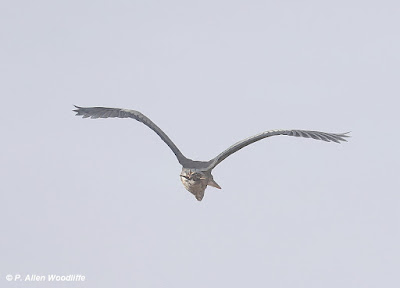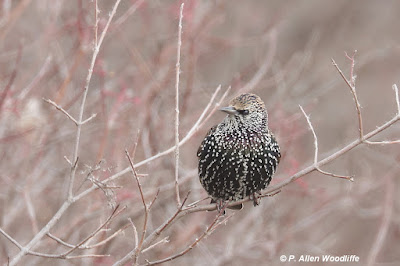With the sudden arrival of wintry weather, I went out looking for Snowy Owls in the former Dover Twp, northwest of Chatham.
It is typically the time when the first ones show up in this area, and there have been one or two reported recently in places farther east. However in spite of my search in places where they are most often found, I came up empty. Last year was a great time to find them early in the season, even up until early January where we tallied a record 23 individuals on the Christmas Bird Count that includes this area.
During my search, a couple of days were quite windy. I was a bit surprised, and concerned, when scenes like this were fairly common.
While there are hedges of cedar and other species, they don't always make much difference, as this next photo shows. This photo was taken at the end of a lengthy hedgerow, and although the wind was blowing from left to right, there isn't much difference in the amount of top soil being blown about from one side of the hedgerow to the other.I realize that due to the very dry conditions, early harvest and such, landowners want to get ahead of tilling the ground rather than waiting for spring. As a result, there is much less corn stubble left on the ground to hold the soil from blowing away, and this may continue for many months until the next planting season.
Also as a result of the lack of stubble on the ground, any Snowy Owls that venture this way may find it less conducive for hunting mice, etc., and therefore will move on. It may be quite a disappointing winter for finding Snowies, but time will tell just how disappointing.
I did manage to find a few other interesting birds to photograph, including the following. There were lots of Horned Larks along the roadways and fields.
A few Sandhill Cranes are still hanging out in the area, including this trio....
.....as well as this pair mixed in with various species of waterfowl in St. Clair NWA.
There were lots of ducks in flight at the NWA, often at quite a distance. This pair of American Black Ducks came by at a reasonable distance and with good light to make it a worthwhile photo.
There were several Great Blue Herons, again at a distance, other than this one which was reluctant to give me anything but a bum look.
European Starlings are often seen, typically in large groups, but sometimes feeding in berry bushes in small numbers.
I usually end up at Rondeau at some point in my travels. With the wind, resulting in vigorous and noisy wave action, it is hard to hear the chips and other sounds that birds are most likely to make at this time. There have been a few migrants such as Fox Sparrows and Dark-eyed Juncos scattered here and there. Rondeau Bay was completely frozen over, at least in view from the park. The warmer temperature of the lake, as well as the steady wave action, has kept the lake open. There are flocks of ducks flying out at a distance, and gulls scattered here and there, some quite close to shore.
 |
| Ring-billed Gull |
 |
| Bonaparte's Gull |
Regular users of the park may be aware of the current Deer Herd Reduction program. It began last weekend, and will continue for the next two weekends. There are deer blinds put up in various location from which the hunters will wait. They won't be very visible from along the trails.
Deer control of one sort or another is necessary given the absence of their historical predators such as Timber Wolves and Black Bears, which were eliminated from the park long before it became a park. There were periodic efforts to keep the number of deer in check up until the early 1970s, but from that period until the early 1990s, for political reasons, there were no efforts at their control. The result was that the numbers sky-rocketed to the point where there were almost 600 deer in the park in the winter. Browse studies conducted by deer specialists indicated that the winter population of deer at Rondeau should be in the 100-125 range. This high population had dire effects on the deer as well as the vegetation in the park. The productivity of the local herd dropped considerably, and too many does were not giving birth to any fawns. In the winter, especially during coldest parts, some individuals were undergoing serious malnutrition, to the point where they would just sit down and die. As for the vegetation, the browse lines were quite evident, and there was a shift in the types of shrubs and trees that were being greatly reduced from the park's ecosystem. In addition, spring wildflowers were almost non-existent.
Some people have argued that there is an increasing number of coyotes in the park which should maintain deer numbers to acceptable levels. While it seems that coyote numbers are increasing, the deer are increasing faster. Also coyotes generally prefer smaller prey but will hunt down a deer when the opportunity arises.
Which brings up another point. Coyotes are a mid-western species and never were a main feature of the heavily forested part of southwestern Ontario. But as the landscape opened up, coyotes arrived in increasing numbers. It is not uncommon for the sharp-eyed traveler to see one off in the distance. The first two photos were taken a year or two ago, in the open landscape of Dover Twp.
They will inhabit some of the few woodlands that remain in Chatham-Kent, as this next photo shows. I discovered a coyote den not far from where this photo was taken.
The increasing number of coyotes has had an impact on other wildlife. Native species such as Red Fox, Eastern Cottontail and Wild Turkey seem to be on a downward population trend across Chatham-Kent in recent years. The next two photos show what used to be a fairly common sight across the agricultural part of C-K.
Non-native species such as Ring-necked Pheasant and European Hare (a.k.a jackrabbit) also seem to have declined. Even at a large natural area such as Rondeau Provincial Park, the effects have been noticeable. Turkeys were doing quite well after they were re-introduced in Chatham-Kent several decades ago. They were seen regularly at Rondeau.
 |
| A 2008 photo at Rondeau |
I have found them to be a lot less common at Rondeau now, an opinion that was shared by a couple of long-term park staff just a few days ago. Turkeys were virtually non-existent on the Blenheim/Rondeau Christmas Bird Counts until 2004, when 26 birds were tallied. The numbers peaked at 349 by 2011, but thereafter gradually diminished so that for the last 4 years, even with an increase in coverage across the count circle, we are hard-pressed to get more than 50 birds on that count.
Even Red Foxes seem to be less common at Rondeau than they used to be. While it certainly is a general concern when native species decline due in part to the arrival of a species that is essentially not-native to the park, it has further effects. One of the natural controls of ticks that can cause Lyme Disease is the presence of Wild Turkeys, as well as Virginia Opossums, who feed on ticks. I noticed a decrease in ticks when the numbers of turkeys and 'possums were increasing. As one who has contracted Lyme Disease on 6 different occasions from Rondeau over a 30 year period, I was glad to see the numbers of turkeys and 'possums increase, along with what appeared to be a decrease in the number of ticks I encountered.
What will this increase in coyotes spell for the future?
Across the landscape of Chatham-Kent there has been an ongoing outlet for local hunters to engage in coyote hunts. On some days in the winter, one can see vehicles and hunters along rural roads and vegetated areas, trying to flush out a coyote or two. I have no numbers to indicate what level of success they have achieved, but have stopped to talk with an occasional hunter. It seems that they have had enough success to continue, and the hunters are certain that there isn't any shortage of coyotes to go after.
This next photo is of a recently shot coyote. I watched as a hunter removed it from the back of his truck and laid it out along the bank of a creek system. In many ways a coyote is a beautiful animal, just like so many other elements of the natural world. But just like a population of White-tailed Deer that gets too numerous for the benefit of so many other elements of nature, something needs to be done.
On a completely unrelated note, I came across this bit of information today, as alarming as it is, by a former vice-president of Pfizer. A short, but informative read here.
If you would like to subscribe, or unsubscribe, to Nature Nuggets, send an email to: prairietramper@gmail.com



















Allen, a very interesting post. You do not have to convince me that deer numbers need to be controlled! I saw it on a much smaller scale in Hanlon Creek in Guelph, where the small deer herd is almost captive, but it is circled by the city, so hunting will never happen!
ReplyDeleteThanks, Furry. Yes, you would be quite knowledgeable about this issue, as it occurs in many places! Thanks for your comment. Allen
DeleteAlways great to hear your thoughts on the natural world Allen, hope you are enjoying the tail end of migration
ReplyDelete